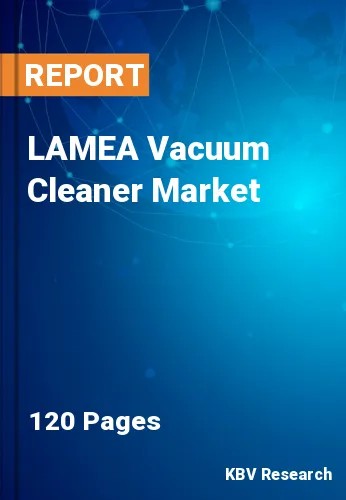The Latin America, Middle East and Africa Vacuum Cleaner Market would witness market growth of 13.1% CAGR during the forecast period (2022-2028).
Vacuum cleaners are available in many models, including portable devices, central vacuum cleaners, battery-powered vacuum cleaners, and many others. Improved infrastructure and the increase in demand for automated and time-saving cleaning solutions are primary drivers for vacuum cleaners. The rise in urbanization, along with increasing standards of living in many developing nations, contributes to the increasing demand for vacuum cleaners.
In addition, the need for energy-efficient vacuum cleaners is expected to rise with the growth of the tech-savvy population and the development of traditional vacuum cleaners. Supermarkets, hypermarkets, retail storefronts, and door-to-door selling are all examples of offline points of sale. With the steady rate of growth, major retailers are expected to remain the most popular place to shop during the projected period.
Before making any purchases, consumers continue to look for in-depth product knowledge, particularly for home appliances. Therefore, by providing something more than what the customer is anticipating, businesses can improve the customer experience. Additionally, the practical advantages of the offline mode of sales channel, like product experience, basic trust in the shop, and product expertise delivered by salespeople, have supported the rise of sales.
The working-age population in Latin America is expected to grow. These young urban workers are essential for building wealth and improving the living standards of the region. In Latin America, demand is rising for household equipment like refrigerators, vacuum cleaners, washing machines, and air conditioners. The forces driving this demand are an expanding middle class with increasing purchasing power and a young population that is increasingly urbanizing and eager for both these essential appliances and premium, smart, & high-value-added items. Additionally, two of the biggest producers in the home appliance sector are based in Brazil. Therefore, the growing demand for vacuum cleaners due to growing urbanization and household appliances demand is propelling the growth of the regional market.
The Brazil market dominated the LAMEA Vacuum Cleaner Market by Country in 2021, and would continue to be a dominant market till 2028; thereby, achieving a market value of $342.5 million by 2028.The Argentina market is experiencing a CAGR of 13.7% during (2022 - 2028). Additionally, The UAE market would display a CAGR of 12.8% during (2022 - 2028).
Based on Distribution Channel, the market is segmented into Online and Offline. Based on Application, the market is segmented into Residential, Industrial and Commercial. Based on Industrial Type, the market is segmented into Manufacturing, Food & Beverages, Construction, Pharmaceuticals and Others. Based on Commercial Type, the market is segmented into Hospital, Hospitality, Retail Stores, Shopping Malls and Others. Based on Product, the market is segmented into Canister, Robotic, Drum, Wet & Dry, Upright, Central and Others. Based on countries, the market is segmented into Brazil, Argentina, UAE, Saudi Arabia, South Africa, Nigeria, and Rest of LAMEA.
Free Valuable Insights: The Worldwide Vacuum Cleaner Market is Projected to reach USD 20.6 Billion by 2028, at a CAGR of 9.6%
The market research report covers the analysis of key stake holders of the market. Key companies profiled in the report include Alfred Karcher SE & Co. KG, Dyson Limited, Ecovacs Robotics Co., Ltd., Emerson Electric Co., Haier Group Corporation, iRobot Corporation (Amazon.com, Inc.), Neato Robotics, Inc. (Vorwerk & Co. KG), Nilfisk Holding A/S, Panasonic Holdings Corporation, and BISSELL, Inc.
By Distribution Channel
By Application
By Product
By Country
Our team of dedicated experts can provide you with attractive expansion opportunities for your business.

